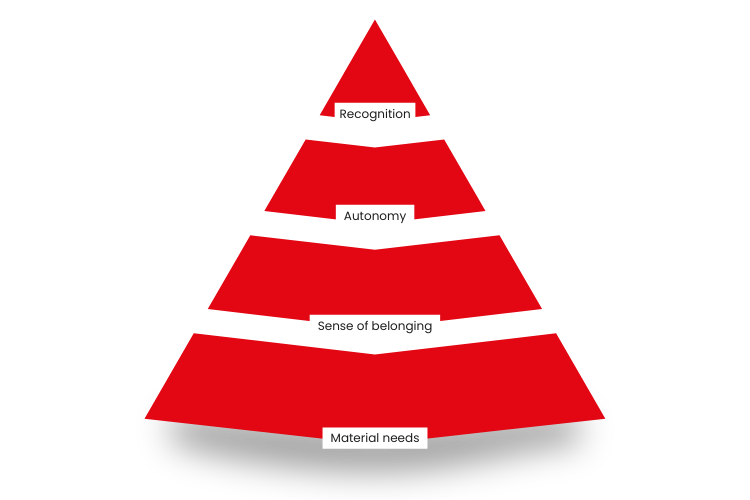Management at distance: don’t let the crisis tarnish your leadership!
The issue of remote management is not new, but it has never been so topical. Indeed, teleworking was already becoming more widespread in many sectors of activity as the difficulties of transport, particularly for cross-border commuters, contributed to accentuating the trend.
The very recent health and containment crisis has precipitated the implementation of remote management.
As we all know, periods of crisis present opportunities for managers and teams to reinvent themselves.
The purpose of this article is twofold. On the one hand, it will serve to explain the pitfalls you need to avoid, so as not to risk weakening your leadership style in these troubled times. On the other hand, it will also provide the opportunity to discuss some of the best practices, managers can adopt to take advantage of the crisis and develop their leadership.
What potential impact can distance have on the relationship between a manager and an employee?
Generally speaking, remote working leads to a change in working habits.
When it comes to telework, the effects are felt in the physical working space, the social environment as well as the organisation of working time. This may mean that a manager will have to adapt his/her expectations about the way work is carried out.
Furthermore, distance inevitably reduces access to informal exchanges (a quick chat in the corridor, the snippets of information gained around the coffee machine, etc.). As communication is more mechanised, access to a variety of communication channels is reduced, this in turn may also increase the risk of misinterpretation (especially with regard to the tone of messages). In addition to all of this, the free exchange of communication may also be affected (as flows are less constant and often reduced to formal channels).
In addition, the existence of physical distance can make things very complicated for a charismatic manager whose leadership style depends greatly on presence and aura.
In the long run, putting distance between a team and its manager inevitably has an impact on communication, feedback, checks and appreciation of work carried out, all of which can make a manager feel that he/she is losing control.
What pitfalls should we avoid and what questions do we need to ask ourselves to avoid weakening our style of leadership?
The best way to answer this question, is to take a quick look at the basic principles of leadership.
Several elements combine to confer this status on a leader:
- Respect of the members of the group (for example, his/her ability to guide the group or for the way (s)he sets a good example).
- If this person takes the initiative to structure the group (for example initiatives relating to the management of relationships between members, definition of working procedures, etc.).
- With respect to product activation (the leader stimulates work and enables the group to achieve objectives that it would not otherwise have achieved).
- Regarding interpersonal sensitivity (a leader is also recognised for his/her ability to identify the needs and expectations of team members).

In short, a leader is recognised as the one who meets the group’s expectations. Similarly, if the needs of the team are no longer accurately identified and taken into account, this may lead to the loss of leadership recognition.
The difficulty is that these needs evolve and even increase in the particular context of remote management. If we take a look at the pyramid representation (inspired by Maslow), we may be able to identify the potential pitfalls a manager needs to avoid.

It is a great mistake to ignore material issues, i.e. the needs of collaborators to carry out their work at distance under good conditions (you need to ensure that basic requirements are met: an adequate internet connection, access to a computer, appropriate software and telephones which work, etc.).
The manager must ensure that social ties within the dispersed team are not eroded (loss of team spirit, lack of mutual aid, absence of solidarity and increased individualism).
There is a real risk of falling into the trap of exercising excessive control (operating at a distance requires the development of trust, distance should not give employees the impression that they must be available for their manager at any time of day or night).
You need to be careful not to be less appreciative of efforts to adapt and in recognising commitment during this period, especially as it can be difficult to cope with. In this particular context, encouragement and recognition are particularly important.
We can also identify other pitfalls linked to the urgency of implementing telework:
- Not paying attention to the development of hyperconnectivity among some employees (any behaviour that may generate bad feelings among the team and generally result in counterproductive situations).
- Letting telework practices evolve in a piecemeal way (if there is a lack of coherence and coordination, such as having one part of the team using Slack software and the other using Skype, etc.).
- Increasing distances or difficulties. Particular care must be taken when introducing physical distance if there is already a cultural “distance” in the team, as it can exacerbate misunderstandings and tensions. Similarly, the context of physical distance with respect to new or inexperienced employees may constitute an additional handicap to their integration and collaboration.
- Not adapting one’s remote management style. As the circumstances in which work is carried out change, so the needs and expectations of the teams change and this means that management must also evolve.
What best practices could you implement to maintain and strengthen your style of leadership at distance?
In order to identify best practices that will enable managers to meet expectations and assert their leadership, we suggest dividing them in three categories based on these 3 key words: aligning, supporting and uniting.
Choosing and facilitating alignment based on the most suitable tools for remote working
There are many tools which support remote working (for example: Slack, Skype, Google Drive, Trello, Dropbox, etc.). If the team does not all use the same tool, explain your choices and make sure that all team members are familiar with them (you may assume this task or delegate it to a team member who is used to working with these tools).
Setting the framework for communication and availability
It is not necessary to ask the team to be potentially available at all times (especially in these particular circumstances where containment can lead to certain constraints: childcare, shared work space, etc.).
Another good practice is therefore to set time slots where everyone must be reachable (e.g. between 9:00 and 11:00 a.m. and between 2:00 and 4:00 p.m.). Employees can then organize the rest of their working day more freely.
In order to avoid an overabundance of messages or the loss of information, it is also advisable to set up rules concerning communication channels. The manager can, for example, decide that priority should be given to e-mail for messages or information that concern the team as a whole. On the other hand, (s)he can specify that the use of the chat channel is more appropriate for targeted requests requiring multiple interactions.
Establish rituals to facilitate coordination
In a changing context, recreating rituals will help to create a feeling of stability and provide points of reference. To achieve this, a manager can, for example:
- Organise a meeting every Monday with the whole team to provide general information and discuss everyone’s tasks for the week ahead.
- At the end of this meeting, send an e-mail summarising everyone’s “to do’s”.
- On Fridays, ask all team members to provide quick feedback on their progress.
It is important to make sure that each employee clearly understands their objectives for the week ahead and that these are well explained. Bear in mind the SMART method (specific, measurable, achievable, realistic and time-bound) in this context.
Finally, it is necessary to set priorities over the week, especially for less experienced employees or those who are less autonomous in their time management.
Make sure that there is sufficient communication
To do this, a balance must be found between the loss of interaction on the one hand and undue stress on the other. Communication must flow in both directions: from the manager to the employees, but also from the employees to the manager.
Such an exchange of information makes it possible to know where the team is at and to avoid feelings of loss of control on the part of the manager or of isolation on the part of certain employees.
Maintain or even strengthen feedback and coaching
It is also important to encourage the team to communicate with the manager (don’t wait until the end of the week to report blockages or difficulties). From a distance, the role of the manager-coach (listening, supporting, providing constructive feedback) facilitates employees’ adaptation and efficiency.
Depending on the size of the team, it may be possible to delegate this responsibility, for example by organising pairs. Indeed, the fact of wanting to assume sole responsibility for responding to employee expectations and demands could quickly exhaust a manager.
Take advantage of these moments to respond to career development needs
If overall professional activity has slowed down, you may decide to make the most of the opportunity to allow team members to take online training courses that interest them. Currently, there is no shortage of online solutions: webinars, MOOCs, tutorials, etc.
Cultivating optimism
Leaders who show they have hope in the future and diffuse a positive attitude, help their employees to find meaning in times of crisis and to stay mobilised. A little humour also goes a long way and helps to promote optimism.
Cultivating team spirit and conviviality
While working remotely, the challenge is to ensure the team does not feel alienated or lacking in cohesion.
One easy way of avoiding this is to propose a virtual coffee break (to keep coffee machine type exchanges).
Another possibility, if it is in line with the corporate culture, can consist in organising so-called “visio-apéros” at the end of the week, for example.
In general, you should not miss out on any opportunity to celebrate small successes (such as the great way everyone coped with the first fortnight of working at a distance).
Crises are synonymous with challenges, but they also constitute great opportunities to evolve.
The current health crisis is no exception to this rule. On the one hand, it is an opportunity to show the team that it is capable of adapting whilst at the same time strengthening the confidence and autonomy that every manager must have in his/her employees. On the other hand, it gives managers the opportunity to anchor and strengthen their leadership by implementing practices grouped around 3 key words: aligning, supporting and uniting.
By encouraging moments of conviviality and celebrating small successes.
If these principles are applied to identify and respond to the needs of the team, then the manager has every chance of emerging from this period, not weakened, but having risen to the challenge, while strengthening his/her leadership style.
Let us support you!
WANT TO RECEIVE OUR LATEST THOUGHT LEADERSHIP CONTENT?
Related posts
 From processes to people: achieving quality
From processes to people: achieving quality
 Daring to lead Positive Transformation: What if Positive Emotional Capital was your key to sustainable change?
Daring to lead Positive Transformation: What if Positive Emotional Capital was your key to sustainable change?
 Why hire Change management professionals? We can do it alone!
Why hire Change management professionals? We can do it alone!
 Digital Transformation and Change Management: Lessons shared in an event hosted by Cebi and MindForest
Digital Transformation and Change Management: Lessons shared in an event hosted by Cebi and MindForest
 Can Engagement Help Reduce Absenteeism?
Can Engagement Help Reduce Absenteeism?




